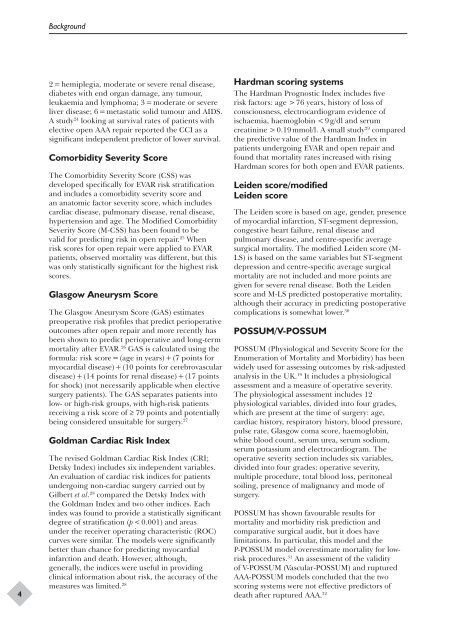Endovascular stents for abdominal aortic aneurysms: a systematic ...
Endovascular stents for abdominal aortic aneurysms: a systematic ...
Endovascular stents for abdominal aortic aneurysms: a systematic ...
Create successful ePaper yourself
Turn your PDF publications into a flip-book with our unique Google optimized e-Paper software.
Background42 = hemiplegia, moderate or severe renal disease,diabetes with end organ damage, any tumour,leukaemia and lymphoma; 3 = moderate or severeliver disease; 6 = metastatic solid tumour and AIDS.A study 24 looking at survival rates of patients withelective open AAA repair reported the CCI as asignificant independent predictor of lower survival.Comorbidity Severity ScoreThe Comorbidity Severity Score (CSS) wasdeveloped specifically <strong>for</strong> EVAR risk stratificationand includes a comorbidity severity score andan anatomic factor severity score, which includescardiac disease, pulmonary disease, renal disease,hypertension and age. The Modified ComorbiditySeverity Score (M-CSS) has been found to bevalid <strong>for</strong> predicting risk in open repair. 25 Whenrisk scores <strong>for</strong> open repair were applied to EVARpatients, observed mortality was different, but thiswas only statistically significant <strong>for</strong> the highest riskscores.Glasgow Aneurysm ScoreThe Glasgow Aneurysm Score (GAS) estimatespreoperative risk profiles that predict perioperativeoutcomes after open repair and more recently hasbeen shown to predict perioperative and long-termmortality after EVAR. 26 GAS is calculated using the<strong>for</strong>mula: risk score = (age in years) + (7 points <strong>for</strong>myocardial disease) + (10 points <strong>for</strong> cerebrovasculardisease) + (14 points <strong>for</strong> renal disease) + (17 points<strong>for</strong> shock) (not necessarily applicable when electivesurgery patients). The GAS separates patients intolow- or high-risk groups, with high-risk patientsreceiving a risk score of ≥ 79 points and potentiallybeing considered unsuitable <strong>for</strong> surgery. 27Goldman Cardiac Risk IndexThe revised Goldman Cardiac Risk Index (CRI;Detsky Index) includes six independent variables.An evaluation of cardiac risk indices <strong>for</strong> patientsundergoing non-cardiac surgery carried out byGilbert et al. 28 compared the Detsky Index withthe Goldman Index and two other indices. Eachindex was found to provide a statistically significantdegree of stratification (p < 0.001) and areasunder the receiver operating characteristic (ROC)curves were similar. The models were significantlybetter than chance <strong>for</strong> predicting myocardialinfarction and death. However, although,generally, the indices were useful in providingclinical in<strong>for</strong>mation about risk, the accuracy of themeasures was limited. 28Hardman scoring systemsThe Hardman Prognostic Index includes fiverisk factors: age > 76 years, history of loss ofconsciousness, electrocardiogram evidence ofischaemia, haemoglobin < 9 g/dl and serumcreatinine > 0.19 mmol/l. A small study 29 comparedthe predictive value of the Hardman Index inpatients undergoing EVAR and open repair andfound that mortality rates increased with risingHardman scores <strong>for</strong> both open and EVAR patients.Leiden score/modifiedLeiden scoreThe Leiden score is based on age, gender, presenceof myocardial infarction, ST-segment depression,congestive heart failure, renal disease andpulmonary disease, and centre-specific averagesurgical mortality. The modified Leiden score (M-LS) is based on the same variables but ST-segmentdepression and centre-specific average surgicalmortality are not included and more points aregiven <strong>for</strong> severe renal disease. Both the Leidenscore and M-LS predicted postoperative mortality,although their accuracy in predicting postoperativecomplications is somewhat lower. 30POSSUM/V-POSSUMPOSSUM (Physiological and Severity Score <strong>for</strong> theEnumeration of Mortality and Morbidity) has beenwidely used <strong>for</strong> assessing outcomes by risk-adjustedanalysis in the UK. 19 It includes a physiologicalassessment and a measure of operative severity.The physiological assessment includes 12physiological variables, divided into four grades,which are present at the time of surgery: age,cardiac history, respiratory history, blood pressure,pulse rate, Glasgow coma score, haemoglobin,white blood count, serum urea, serum sodium,serum potassium and electrocardiogram. Theoperative severity section includes six variables,divided into four grades: operative severity,multiple procedure, total blood loss, peritonealsoiling, presence of malignancy and mode ofsurgery.POSSUM has shown favourable results <strong>for</strong>mortality and morbidity risk prediction andcomparative surgical audit, but it does havelimitations. In particular, this model and theP-POSSUM model overestimate mortality <strong>for</strong> lowriskprocedures. 31 An assessment of the validityof V-POSSUM (Vascular-POSSUM) and rupturedAAA-POSSUM models concluded that the twoscoring systems were not effective predictors ofdeath after ruptured AAA. 32
















